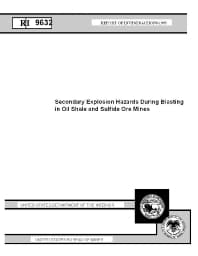Mining Publication: Secondary Explosion Hazards During Blasting in Oil Shale and Sulfide Ore Mines
Original creation date: November 1995
Authors: ES Weiss, KL Cashdollar, MJ Sapko, EM Bazala
NIOSHTIC2 Number: 20000772
Pittsburgh, PA: U.S. Department of Energy, RI 9632. NTIS stock number: PB97-127658, 1995 Nov; :1-50
The data presented in this report are the results, to date, of an ongoing research program on the explosion hazards associated with blasting operations in noncoal mines. Tests conducted at the cannon gallery at Lake Lynn Laboratory near Fairchance, Fayette County, PA, provided a means of evaluating the relative incendivity characteristics of new and existing explosive products. Three explosives-- a pumpable emulsion-ANFO blend, a packaged water gel, and an emulsion blasting agent-exhibited low-incendive qualities compared with other more highly incendive products such as ANFO and some dynamites. Based on the data collected during numerous full-scale blasts in oil shale and sulfide ore mines, the low-incendive products significantly reduced or eliminated the ignition hazards while at the same time providing effective fragmentation of the rock. Based on the positive results from the gallery and field testing, low-incendive explosives, coupled with good blasting procedures, show promise in reducing dust and/or gas ignitions associated with blasting operations in oil shale and sulfide ore mining applications.

NIOSHTIC2 Number: 20000772
Pittsburgh, PA: U.S. Department of Energy, RI 9632. NTIS stock number: PB97-127658, 1995 Nov; :1-50